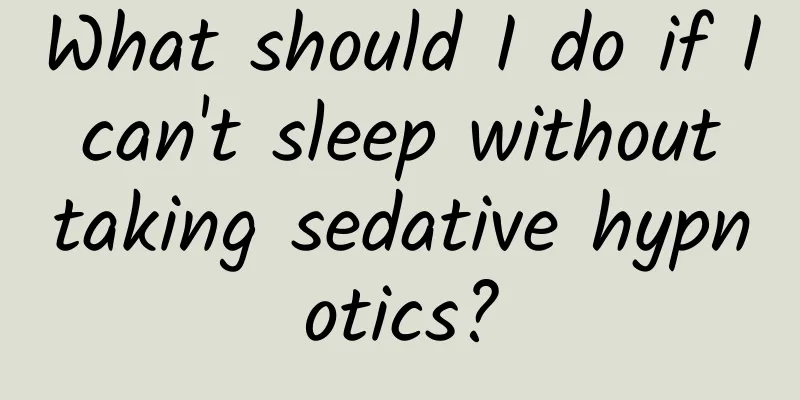What should I do if I can't sleep without taking sedative hypnotics?

|
Author: Wang Changhong, Chief Physician of the Second Affiliated Hospital of Xinxiang Medical College Gao Chang, Associate Professor, Jining Medical College Reviewer: Zhang Ruiling, Chief Physician, Second Affiliated Hospital of Xinxiang Medical College Many people with anxiety and insomnia choose to take sedatives and hypnotics to help them fall asleep. However, some people may not be able to go to the hospital for treatment due to certain special circumstances, and thus cannot take the medicine under the professional guidance of a doctor, which may lead to abuse and addiction of sedatives and hypnotics. Figure 1 Copyright image, no permission to reprint 1. The effect of sedative hypnotic drugs Sedatives and hypnotics are divided into three categories: short-acting, medium-acting, and long-acting. Short-acting and medium-acting drugs are mostly used to treat insomnia, while long-acting drugs are mostly used to treat anxiety disorders and alcohol addiction withdrawal. In general, sedatives, especially benzodiazepines, are well tolerated, safe and effective in the short term, but long-term use may cause physiological and psychological adverse reactions, increase tolerance, reduce effectiveness, and cause symptoms such as drug dependence and withdrawal. Therefore, the long-term use of benzodiazepines should be limited. How does addiction to sedatives and hypnotics develop? After long-term use of sedatives and hypnotics, the patient's tolerance increases, and the effectiveness of the drug in improving insomnia gradually decreases. The patient must increase the dose to achieve the same effect as before. In addition, long-term use of sedatives and hypnotics can easily make patients dependent on the drug. If the dose is reduced or the drug is stopped, the body will show obvious withdrawal symptoms. Figure 2 Copyright image, no permission to reprint 2. How to identify sedative hypnotic drug addiction Users of sedatives and hypnotics can compare their own conditions and identify drug abuse and addiction from clinical characteristics. If necessary, they can seek help from medical professionals and relevant institutions. First of all, we need to understand the type, time, dosage and method of use of sedatives and hypnotics taken by the user, and at the same time determine whether the user has the following situations: ① Whether the dosage is getting larger and larger, or even out of control; ② Whether other psychoactive substances such as alcohol, tobacco, opioids, etc. are used at the same time; ③ Whether physical and psychological discomfort occurs after reducing or stopping use; ④ Whether serious adverse consequences are caused by the use of sedatives and hypnotics; ⑤ Whether the user is willing to reduce or stop using sedatives and hypnotics. Next, you can identify and judge the addiction to sedatives and hypnotic drugs by comparing the following clinical characteristics. •Psychological craving : The core symptom of drug addiction is manifested by a strong desire to obtain the pharmacological effects of the drug again. • Uncontrolled drug use : It is the core symptom of drug addiction, characterized by difficulty controlling the timing and dosage of drug use, difficulty stopping use, and difficulty controlling the desire to obtain drugs. •Increased tolerance : The dose must be increased to obtain the previous effect, or the original dose no longer achieves the previous effect. • Acute withdrawal symptoms : Once the drug is stopped or the dosage is reduced, obvious withdrawal symptoms will occur, such as gastrointestinal symptoms, sweating, tremors, dizziness, headaches, hypersensitivity to sounds and smells, restlessness, insomnia, anxiety, irritability, tinnitus, and a sense of depersonalization. The above symptoms are usually mild and generally last for a few days to a few weeks. In severe cases, epileptic seizures, delirium, and high fever may occur. •Other adverse consequences : behavioral disinhibition, impaired operational ability, cognitive impairment, and epileptic seizures, which in turn affect normal life and work. If the user has already shown the above-mentioned clinical symptoms of drug addiction, it should be taken seriously and actively addressed. 3. How to deal with addiction to sedatives and hypnotic drugs First of all , drug abusers and addicts should minimize or avoid the use of sedatives and hypnotics unless necessary. They can first try the following methods to improve sleep. • Adjust your biological clock and develop good sleeping habits. Avoid strenuous and exciting activities 2 hours before bedtime, do not drink strong tea, coffee and other stimulating beverages, and stay away from mobile phones and other electronic products before bedtime. Do relaxing and enjoyable things at night, such as soaking your feet in hot water or taking a warm bath, listening to soothing music, etc. Try to have a regular schedule and go to bed and get up on time. •Perform mindfulness training to help relieve insomnia. Figure 3 Copyright image, no permission to reprint •Talk to your family or someone you trust. You can use the “group warmth” approach to help yourself solve the emotional and sleep problems you encounter. •Perform cognitive behavioral therapy. Secondly , family members of sedative hypnotic users should pay special attention to the proper storage of the drugs. They can indirectly understand the drug use of the patients by observing the daily rhythm of the patients. Long-term use of sedative hypnotic drugs is prone to drug resistance and dependence, so they should be used alternately and try to avoid long-term use of the same drug. The use of sedative hypnotic drugs should be limited to 4 weeks. If insomnia still occurs after 4 weeks of using a drug, it is recommended to switch to another drug to reduce drug tolerance. Finally , if sedative-hypnotic drug abusers and addicts cannot improve their sleep after trying the above methods, or if the addiction to sedatives and hypnotic drugs is severe and difficult to quit by self-help, it is recommended to seek help from professionals, regularly consult and receive addiction medicine treatment to quit sedative-hypnotic drug abuse and addiction. Feeling anxious and fearful is a normal reaction when facing an emergency. Mild tension and anxiety may affect sleep, but it is also helpful for individuals to maintain a state of alertness. Therefore, when anxiety and fear occur, there is no need to be overly nervous. You should remind yourself to take precautions. You can also relieve tension, anxiety and other negative emotions through relaxation training and other methods. These measures can improve sleep. |
>>: Misconceptions and disease signals of three common symptoms
Recommend
How long do I need to rest after an abortion?
In today's society, young girls often have un...
Can pregnant women take metronidazole effervescent tablets?
Metronidazole effervescent tablets are often used...
Why do women wear makeup? You will be shocked after reading this.
1. Even a pair of lifeless leather shoes needs sh...
Can I sweat after a caesarean section?
Many people think that pregnant women have heavy ...
The difference between cervical curettage and biopsy
There are many routine examination methods for mo...
What is the best way to treat cervical erosion?
With the significant improvement of modern scienc...
Questions about myopia surgery: Will the laser used in laser myopia surgery go astray?
When it comes to myopia surgery, everyone becomes...
What antipyretic medicine should I take when I have a fever during breastfeeding?
In daily life, it is easy to catch a cold due to ...
Why does I have a low fever during ovulation?
A low fever does not mean that the body temperatu...
[Medical Q&A] Can varicocele be detected through self-examination?
Planner: Chinese Medical Association Reviewer: Zh...
How many sit-ups should you do? One look and you'll know
The abdomen is the place where fat is most likely...
What are the methods of reading articles? What is the role of various descriptive methods in reading questions?
Reading is to break through limitations and gain ...
Why do pregnant women often go to the toilet?
In fact, during pregnancy, a woman's body has...
Normal episiotomy wound recovery picture
The episiotomy wound is very familiar to women wh...









